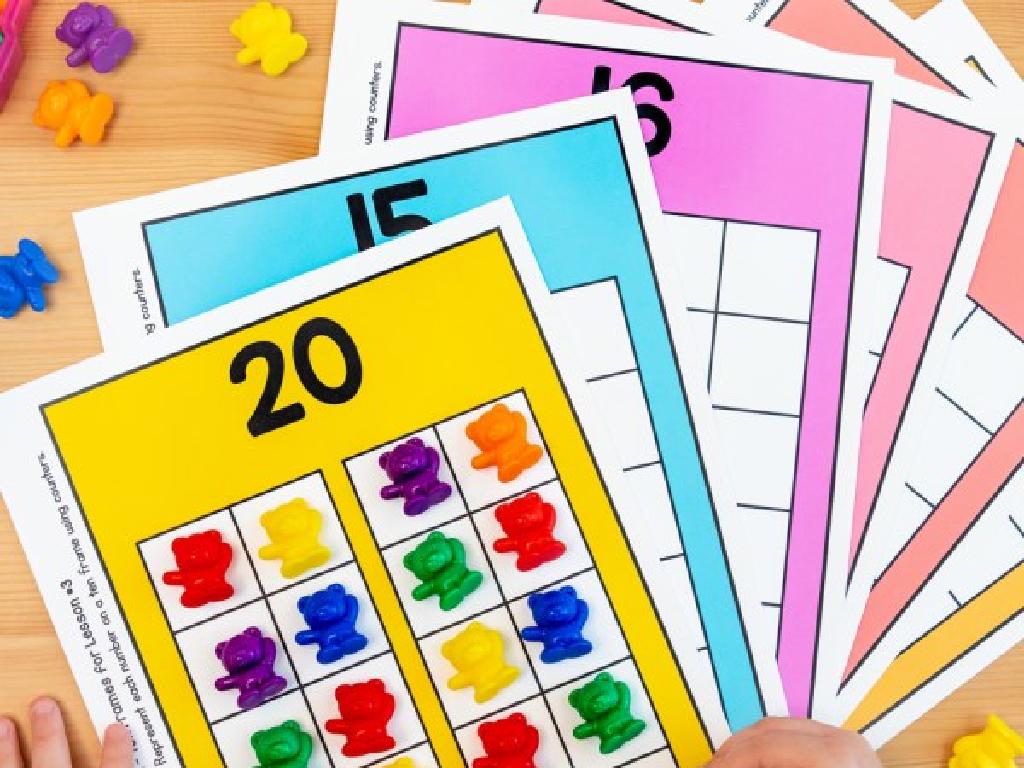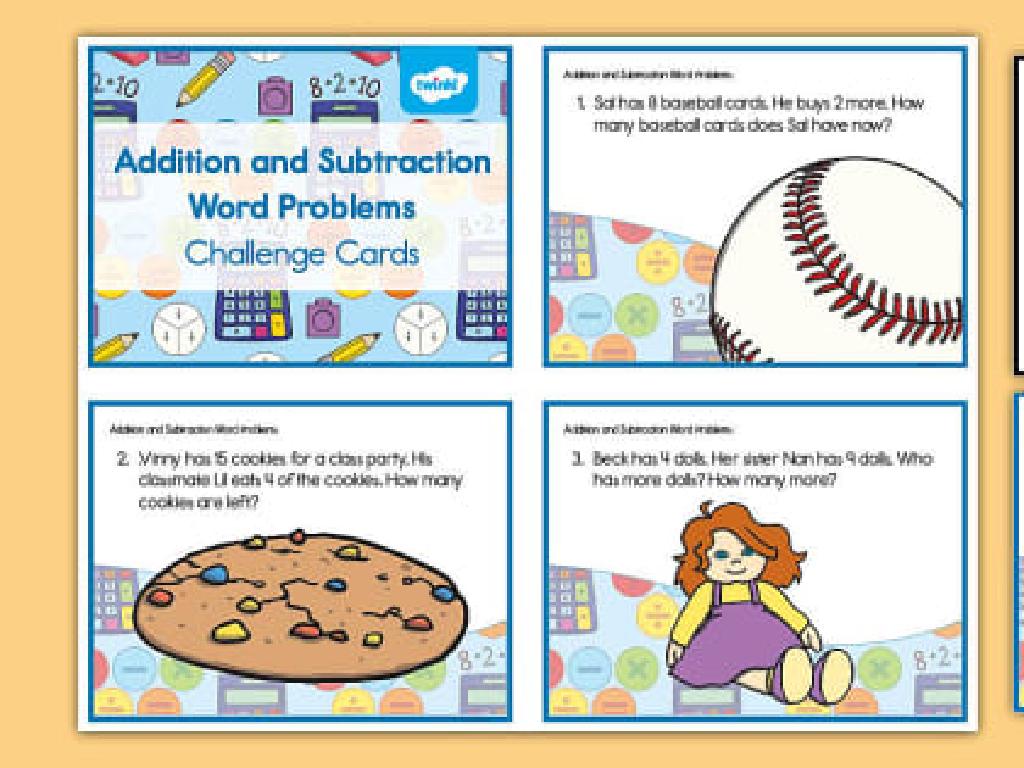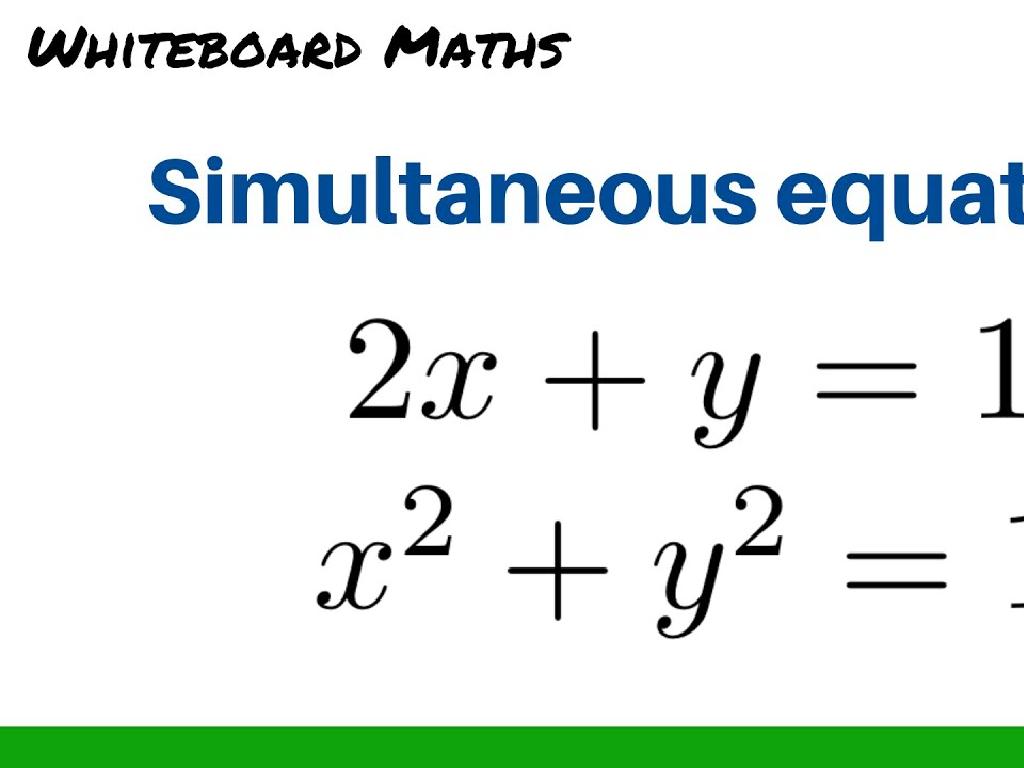Identify Statistical Questions
Subject: Math
Grade: Sixth grade
Topic: Statistics
Please LOG IN to download the presentation. Access is available to registered users only.
View More Content
Welcome to Statistics: Identifying Statistical Questions
– Statistics: A world of data
– What are statistical questions?
– Questions that anticipate variability in data and can be answered with data collection.
– Characteristics of statistical questions
– They require data that vary and have different possible outcomes.
– Examples and non-examples
– ‘How tall are the students?’ vs. ‘How tall is John?’
|
This slide introduces students to the concept of statistics as a tool for understanding the world through data. Emphasize that statistics is not just about numbers, but about asking the right questions that can be explored with data. Explain that statistical questions are ones that expect variability and can be answered by collecting data, which may have multiple outcomes. Provide clear examples and non-examples to help students differentiate between statistical and non-statistical questions. For instance, a question about the height of all students in class is statistical because it expects varied answers, whereas a question about a single student’s height is not. Encourage students to think of their own statistical questions related to their interests.
Understanding Statistical Questions
– Define a statistical question
– A question that anticipates variability in the data related to the question.
– Characteristics of statistical questions
– They require data collection and analysis, and have more than one possible answer.
– Compare examples and non-examples
– ‘How tall are the students?’ vs. ‘How tall is John?’
– Practice identifying them
|
This slide introduces the concept of statistical questions, which are fundamental in the study of statistics. A statistical question is one that can be answered by collecting data that vary and typically has more than one possible answer. Characteristics include the anticipation of variability and the need for data collection and analysis. Provide clear examples of statistical questions, such as those related to heights, preferences, or ages, and contrast them with non-examples that have only one possible answer. Encourage students to think of their own questions and determine if they are statistical or not. This will help them grasp the concept and apply it to real-world situations.
Exploring Examples of Statistical Questions
– Example 1: TV watching hours
– How many hours do students watch TV weekly?
– Example 2: Popular lunch food
– Which lunch food do students prefer most?
– Characteristics of statistical questions
– They require data collection and analysis
– Discussing the ‘why’
– Understand the need for data to answer
|
This slide aims to provide students with concrete examples of statistical questions. Example 1 asks for the number of hours spent watching TV, which can vary among students and requires data collection to answer. Example 2 inquires about the most popular lunch food, which also needs data to determine the favorite among students. Both examples illustrate that statistical questions are those that can be answered by collecting data from a group and analyzing it. Encourage students to think about what makes these questions statistical and how they would go about collecting the necessary data to answer them. This discussion will help them grasp the concept of statistical questions and their importance in making informed decisions based on data.
Understanding Non-Statistical Questions
– Non-statistical question examples
– Example 1: What is your name? Example 2: What color is the school bus?
– Analyze ‘What is your name?’
– This question has a unique answer for each individual.
– Examine ‘What color is the school bus?’
– The answer is consistent; it doesn’t vary or involve data collection.
– Discuss why these lack statistics
|
This slide aims to clarify what non-statistical questions are by providing clear examples. A non-statistical question is one that does not require data collection, analysis, or variability for the answer. For instance, ‘What is your name?’ is specific to an individual and does not involve variability or data that can be analyzed. Similarly, ‘What color is the school bus?’ has a standard answer and does not involve collecting data from different instances. These examples help students understand that statistical questions involve a level of uncertainty and require data to answer, which is not the case with these examples. Encourage students to think of other non-statistical questions and discuss why they do not fit into the category of statistical questions.
Identifying Statistical Questions
– What are statistical questions?
– Questions that anticipate variability in data and require data collection to answer.
– Contrast with non-statistical questions
– Questions with definitive, unchanging answers, not requiring data.
– Significance of data in questions
– Understanding data’s role helps distinguish between statistical and non-statistical questions.
– Examples to illustrate differences
– ‘How tall are the students?’ vs ‘How tall is the door?’
|
This slide aims to help students differentiate between statistical and non-statistical questions. Statistical questions are those that expect a variety of answers and need data collection and analysis to provide a response. In contrast, non-statistical questions have fixed, certain answers. Emphasize the importance of data in formulating and answering statistical questions. Provide clear examples to illustrate the differences, such as comparing a question about the varying heights of students (statistical) with a question about the height of a door (non-statistical). Encourage students to think of their own examples and to consider why understanding the type of question is crucial in the field of statistics.
Group Activity: Identifying Statistical Questions
– Work in groups on a list
– Discuss choices with the class
– Explain reasons for choices
– Understand what makes a question statistical
– A statistical question is one that can be answered by collecting data and where you expect variability in the data.
|
This group activity is designed to engage students in collaborative learning. Divide the class into small groups and provide each group with a list of questions. Instruct them to identify which questions are statistical, meaning they require data collection and have variability in their answers. After the group work, bring the class together for a discussion where each group shares their findings and explains their reasoning. This will help students understand the concept of statistical questions and how they differ from other types of questions. As a teacher, facilitate the discussion by asking probing questions and providing feedback. Possible activities could include identifying statistical questions from a newspaper, creating their own survey questions, or analyzing data from simple classroom experiments.
Activity: Crafting Statistical Questions
– Understand a statistical question
– Choose a topic of interest
– Think about hobbies, sports, or favorite subjects
– Create your own question
– Make sure it’s a question that can be answered with data
– Share with the class
|
This activity is designed to engage students with the concept of statistical questions by allowing them to create their own based on their interests. A statistical question is one that can be answered by collecting data and where you expect to get a variety of different answers. Encourage students to think about areas that are relevant to their lives, such as their hobbies, sports teams, or favorite school subjects. Guide them to formulate questions that can be answered with data, such as ‘How many minutes do students in our class spend on homework each night?’ rather than questions with only one possible answer. After creating their questions, students will have the opportunity to share with the class, fostering a collaborative learning environment. Provide 4-5 examples of good statistical questions to help them get started.
Class Activity: Data Hunt
– Find data to answer a statistical question
– Collect data in groups around the school
– Work together to gather information
– Present your group’s findings
– Use charts or graphs to show your data
– Discuss how data answers the question
– Explain the relevance of your data to the question
|
This activity is designed to engage students with practical application of statistics. Divide the class into small groups and assign them to find data around the school that could answer a statistical question, such as ‘How many books per topic are in the library?’ or ‘What is the average number of students in each classroom?’. They should collect this data and then present their findings to the class using visual aids like charts or graphs. After presentations, lead a discussion on how the collected data provides answers to the posed statistical questions. This will help students understand the importance of data collection and analysis in statistics. Possible variations of the activity could include comparing data between grades, analyzing lunch choices, or measuring the frequency of certain behaviors during recess.
Conclusion & Homework: Understanding Statistical Questions
– Review: Statistical vs. Non-Statistical Questions
– Homework: Find a statistical question example
– Look for questions that involve data collection and analysis
– Source: News article or online
– Ensure the source is reliable and age-appropriate
– Share findings in the next class
– Be ready to explain why it’s a statistical question
|
As we wrap up today’s lesson on identifying statistical questions, students should be able to distinguish between questions that can be answered with data (statistical) and those that cannot (non-statistical). For homework, students are tasked with finding real-world examples of statistical questions from news articles or online sources, which will help them apply what they’ve learned in a practical context. Encourage them to choose reliable sources and be prepared to discuss why the selected question is statistical, focusing on the aspect of data collection and analysis. This activity will reinforce their understanding and provide a foundation for our next class discussion.






